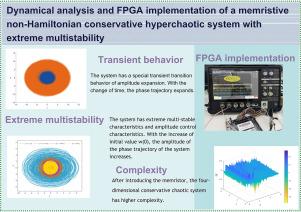Dynamical analysis and FPGA implementation of a memristive non-Hamiltonian conservative hyperchaotic system with extreme multistability
IF 2.5
3区 工程技术
Q3 COMPUTER SCIENCE, HARDWARE & ARCHITECTURE
引用次数: 0
Abstract
Recent studies indicate that coupling a memristor with a nonlinear circuit can generate more complex dynamical behaviors. However, research on high-dimensional memristor-based conservative systems remains scarce, and existing low-dimensional memristive systems have yet to exhibit rich dynamic characteristics. In this work, we integrate a magnetically controlled memristor into a conservative chaotic circuit, proposing a novel four-dimensional memristive non-Hamiltonian conservative hyperchaotic system (MHHS) with hidden chaotic dynamics. Through dissipation analysis, Lyapunov exponents, and energy evolution, we verify the system’s non-Hamiltonian conservative properties and hyperchaotic nature. The MHHS system demonstrates high sensitivity to initial conditions and parameters, exhibiting extreme multistability phenomena governed by Hamiltonian energy variations. Phase-space analysis reveals diverse multistable attractors under different initial conditions. Time-series analysis further identifies three distinct transition behaviors: (1) amplitude expansion, (2) quasiperiodic-to-hyperchaotic transitions, and (3) the coexistence of multiple topological states. The system’s chaotic sequences pass the NIST randomness tests, confirming strong pseudorandomness, while Shannon entropy (SE) complexity analysis highlights their high unpredictability. Finally, we implement the MHHS system on FPGA hardware using the fourth-order Runge–Kutta method, experimentally validating its physical realizability. This study not only advances the theoretical understanding of conservative hyperchaotic systems but also provides practical foundations for high-security chaos-based encryption applications.

极端多稳定记忆非哈密顿保守超混沌系统的动力学分析与FPGA实现
近年来的研究表明,将忆阻器与非线性电路耦合可以产生更复杂的动态行为。然而,对基于高维忆阻器的保守系统的研究仍然很少,现有的低维忆阻系统还没有表现出丰富的动态特性。在这项工作中,我们将磁控忆阻器集成到保守混沌电路中,提出了一种新的具有隐藏混沌动力学的四维忆阻非哈密顿保守超混沌系统(MHHS)。通过耗散分析、李雅普诺夫指数和能量演化,验证了系统的非哈密顿保守性和超混沌性质。MHHS系统对初始条件和参数具有很高的敏感性,表现出由哈密顿能量变化控制的极端多稳定性现象。相空间分析揭示了不同初始条件下不同的多稳定吸引子。时间序列分析进一步确定了三种不同的转变行为:(1)振幅扩张,(2)准周期到超混沌的转变,以及(3)多个拓扑状态共存。该系统的混沌序列通过了NIST的随机性测试,证实了其强伪随机性,而香农熵(Shannon entropy, SE)复杂度分析则突出了其高不可预测性。最后,我们利用四阶龙格-库塔方法在FPGA硬件上实现了MHHS系统,实验验证了其物理可实现性。该研究不仅提高了对保守超混沌系统的理论认识,而且为基于混沌的高安全性加密应用提供了实践基础。
本文章由计算机程序翻译,如有差异,请以英文原文为准。
求助全文
约1分钟内获得全文
求助全文
来源期刊

Integration-The Vlsi Journal
工程技术-工程:电子与电气
CiteScore
3.80
自引率
5.30%
发文量
107
审稿时长
6 months
期刊介绍:
Integration''s aim is to cover every aspect of the VLSI area, with an emphasis on cross-fertilization between various fields of science, and the design, verification, test and applications of integrated circuits and systems, as well as closely related topics in process and device technologies. Individual issues will feature peer-reviewed tutorials and articles as well as reviews of recent publications. The intended coverage of the journal can be assessed by examining the following (non-exclusive) list of topics:
Specification methods and languages; Analog/Digital Integrated Circuits and Systems; VLSI architectures; Algorithms, methods and tools for modeling, simulation, synthesis and verification of integrated circuits and systems of any complexity; Embedded systems; High-level synthesis for VLSI systems; Logic synthesis and finite automata; Testing, design-for-test and test generation algorithms; Physical design; Formal verification; Algorithms implemented in VLSI systems; Systems engineering; Heterogeneous systems.
 求助内容:
求助内容: 应助结果提醒方式:
应助结果提醒方式:


